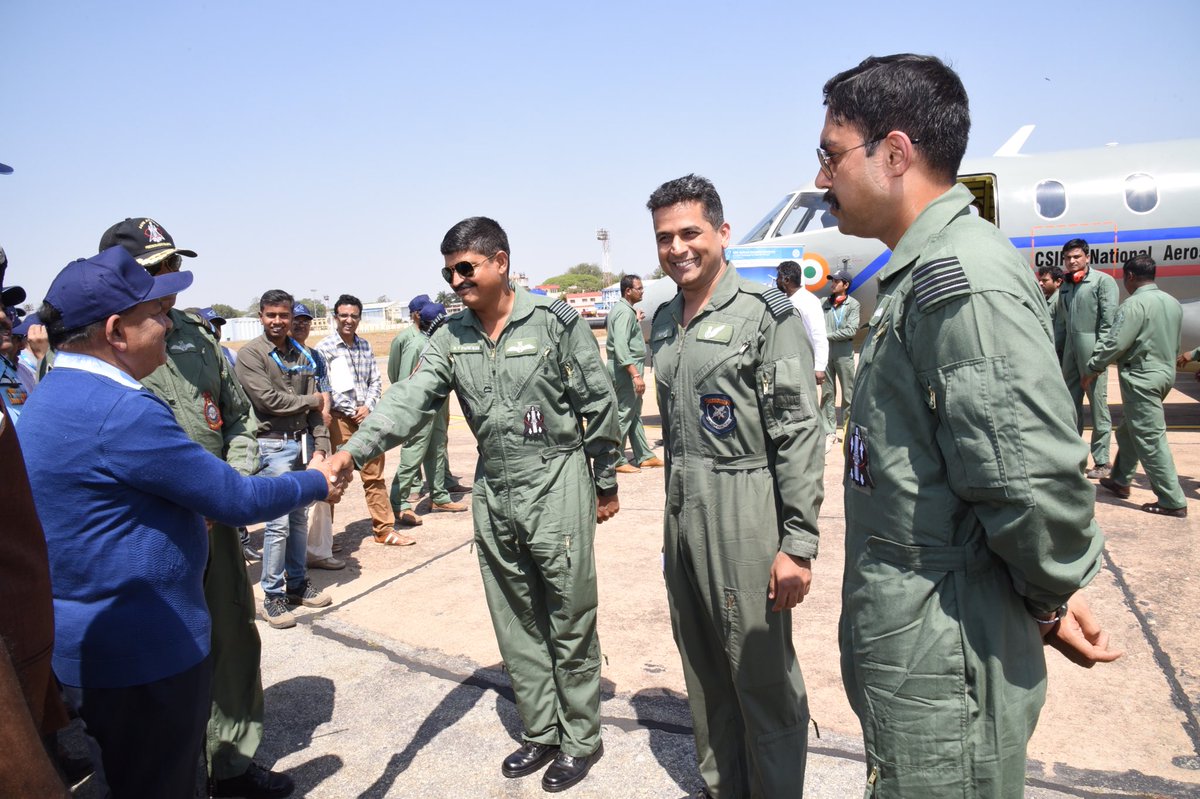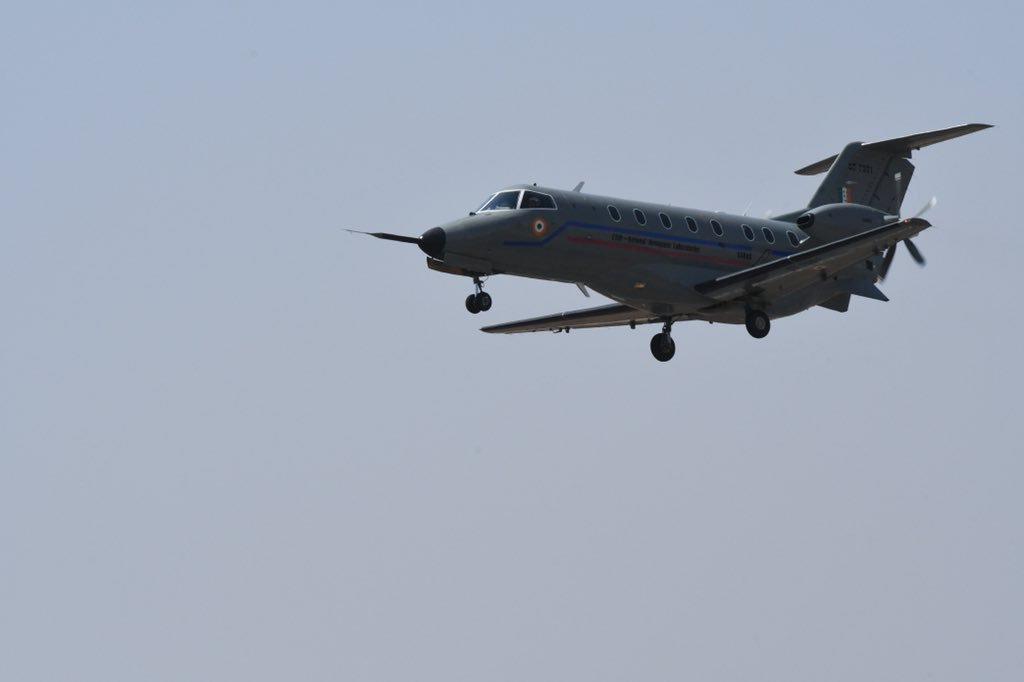
India is headed into perhaps its most viciously fraught election season in history. The country is already very much in election mode and the atmosphere brings with it an inevitability: no much qualifies anymore as hands-off for a political attack. And with a major election up in a few weeks in the southern state of Karnataka, considered India’s aerospace hub, open political hostilities find themselves manifested nearly everywhere. As they did on February 21 at the HAL Airport in Karnataka’s capital Bengaluru.
The occasion was the second flight of India’s troubled Saras light civil aircraft since it returned to the air last month after a nine-year grounding compelled by a prototype crash in 2009. The first flight a month earlier on Jan 24 was a quiet affair without VIP guests. Now confident enough to show off the aircraft, the aircraft’s developers, the National Aerospace Laboratories (NAL), decided to have the country’s Science & Technology Minister attend as chief guest. It was here that troubles that have coursed through the program bubbled to the surface in the form of a sharp political broadside.
“The project was dumped by the previous government, after an accident during test flight in 2009,” Minister Dr. Harsh Vardhan said. “Though the Directorate General of Civil Aviation, DGCA had exonerated the aircraft from any design flaw or poor-quality production, no effort was made to revive the project.”
For Harsh Vardhan’s party the BJP, the mission in Karnataka is to wrest power from the ruling Congress, while it is precisely the opposite next year in the general election. Any stage, in this atmosphere, is politically weaponised, as the minister demonstrated.
“The credit for reviving the indigenous project goes to the present government headed by Narendra Modiji, who had given a thrust to ‘Make in India’ mission,” the Harsh Vardhan thundered, before going on to credit the military agencies involved in bringing the Saras aircraft program back to life.

Minister Harsh Vardhan’s attack may have been a political one, but it casts a fresh and specific light on an aircraft program that seemed to meander aimlessly following the 2009 crash, with neither official closure, nor the impetus to quickly return to flight test swiftly. As Science & Tech minister, Dr Harsh Vardhan’s barb is aimed specifically at his predecessor, including Congress Party stalwarts Kapil Sibal (who was minister during and until shortly after the crash), Pawan Kumar Bansal, the late Vilasrao Deshmukh and Jaipal Reddy. A Congress Party response on the allegations has been sought by Livefist and will be updated here.
In a press statement, the Ministry of Science & Technology’s Council for Scientific & Industrial Research (CSIR) that governs NAL noted even more specifically, “After the project was revived by the present government, NAL has incorporated design modifications and improvements on the SARAS PT 1 model, like 2×1200 shp engines and 104-inch diameter propeller assembles to cater to second segment climb gradient requirements, improved flight control system, rudder area, main wheel and brakes to cater to 7100 kg AUV, indigenously developed stall warning system, etc.”
The merits of the Saras aircraft program aside, the allegations are heavy with implication. They amount to the present government accusing its predecessor administration of attempting to quietly kill off a project on which upwards of Rs 350 crore (about $53 million) have already been spent, with a roughly equal amount to be spent on proving the revived and improved version.
“Its successful development will be one of the game changers in the history of civil aviation in India,” the minister said in Bengaluru, in perhaps the most generous words anyone has used thus far for the beleaguered Saras.
An NAL officer who wished not to be named said, “While it is true that the Saras program was not shut down officially, there were delays and it seemed to us that the government of the time had lost interest in pushing the program. It was a big challenge to keep teams motivated to press on with the project.”
In an interview to Livefist last year, NAL director Jitendra Jadhav provided a more detailed, nuanced account of the delays. He said:
“After the unfortunate accident on 6th March, 2009, all the activities related to SARAS aircraft had to be stopped till completion of accident investigation by DGCA and subsequent implementation of recommendations thereon. The investigation absolved CSIR-NAL of any design deficiencies, but attributed the cause to procedural deficiencies. Other major factors for this delay in resumption of programme were: Change of Regulatory body from DGCA to CEMILAC to meet certification requirements of IAF as the possible launch customer; re-orientation time for CSIR-NAL to the procedures of military certification agency and the time for the regulatory body to get a grasp on the project, as the entry was lateral and at an advanced stage of project. By the time the first prototype was modified and ready for Taxi trials at the end of year 2013, the project had reached its date of completion and CSIR-NAL had to wait for a formal approval from Govt to continue further. This was crucial as the project had important stake holders like HAL, IAF, CEMILAC and DGAQA towards further flight testing and certification of SARAS.”
Political crossfire aside, the revived Saras aircraft program is on an ambitious slope. If it suffered from a disinterested government in the past, the present government appears, on the face of it at least, to be moving full throttle, even positioning the Saras as a worthy counter to several proven air platforms in the international market. Sample this from the Ministry’s statement:
The aircrafts currently available in the international market are of 1970’s technology, such as Beechcraft 19000D. Dornier-228, Embraer EMB 110. They have higher fuel consumption, lower speeds, unpressurised cabin, high operating cost and unsuitable for operations from hot and highaltitude airfields. After India began its light transport aircraft project, countries like Russia, China, USA, Indonesia and Poland have launched new programmes for development of next generation 19-seater aircraft. On the other hand, the upgraded SARAS Mk2 version has considerable drag/weight reduction with unique features like high cruise speed, lower fuel consumption, short landing and take-off distance, low cabin noise, operable from high and hot airfield, with pressurised cabin, operable from semi prepared airfield and low acquisition and maintenance cost.
The Saras has 18 more flights to complete before NAL can freeze a final product configuration that can be offered to the Indian Air Force and civil customers.

This is to be expected. Rafale deal has been needlessly politicised , it is a govt to govt deal.
The pity is not just opposition , but even “professional strategists” have fallen pray to the disease of critizing all deals.
We need to decide faster .
Just hope we do not keep decisions away in the whole process.
I may be wrong but I feel the LCA was also almost in the grave yard due to the United Progressive Alliance 1 and 2. Thanks to the NDA that IAF (Imported Air Force) has now put some order in HAL’s kitty otherwise LCA was destine to be Marut 2.